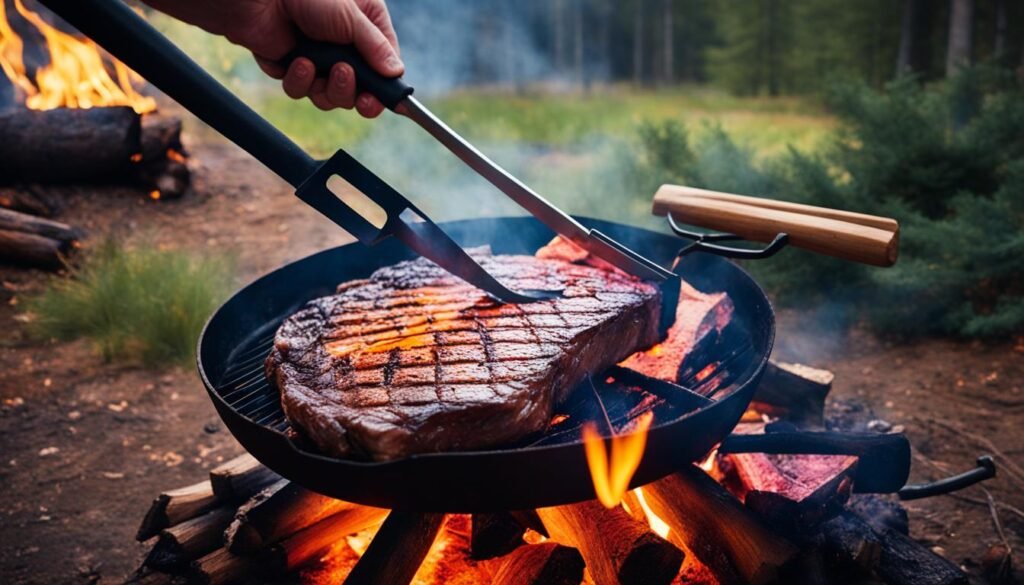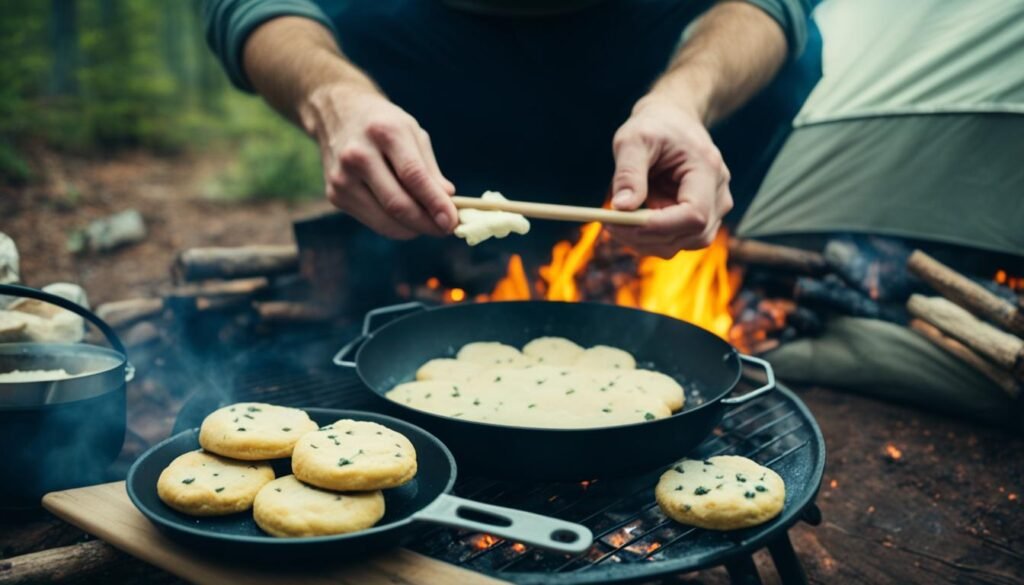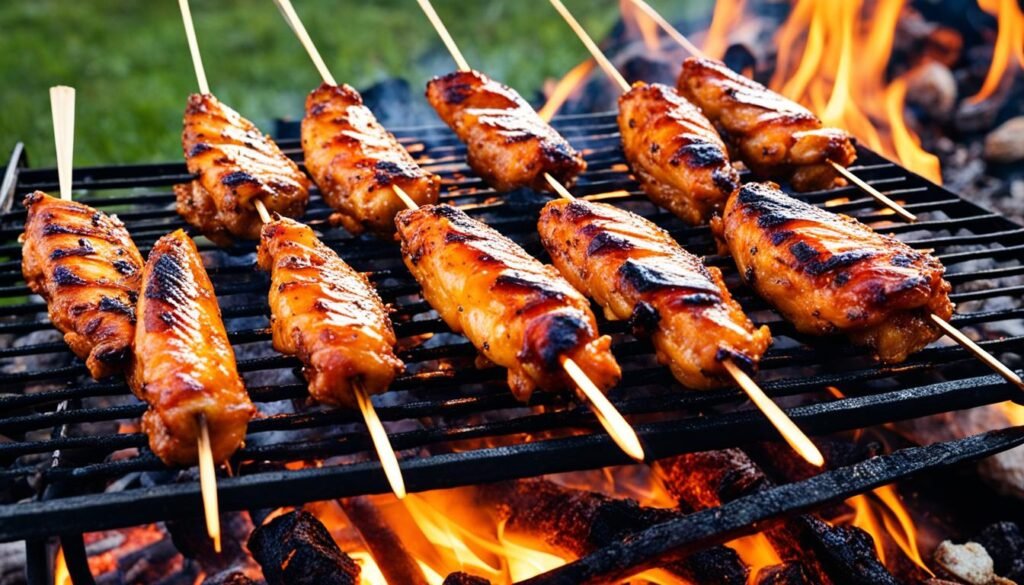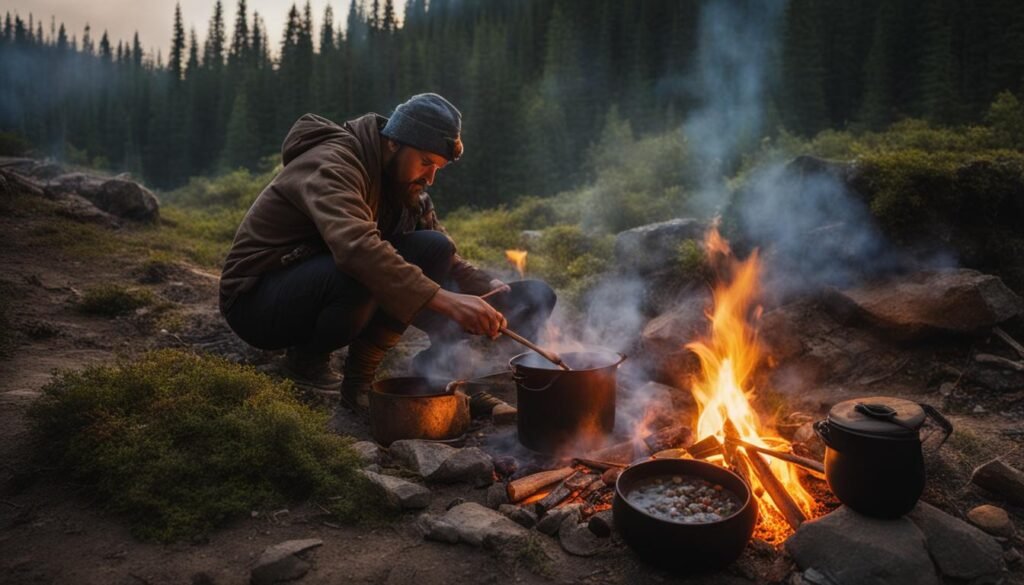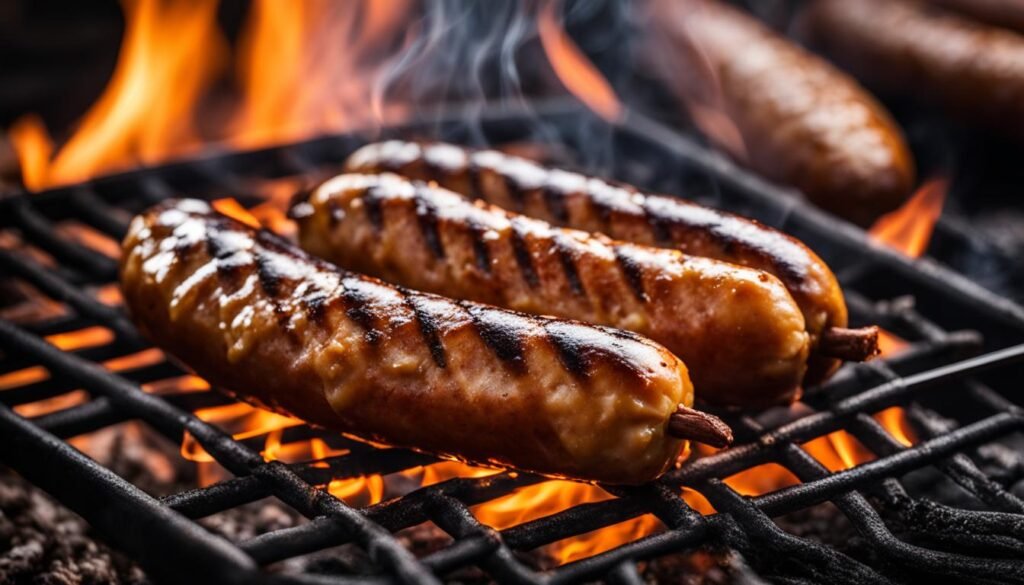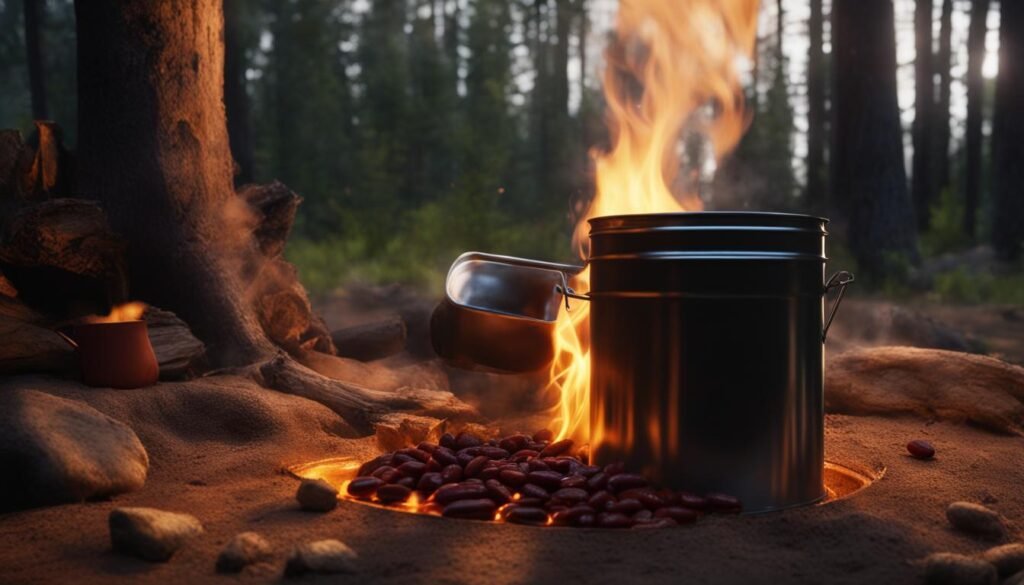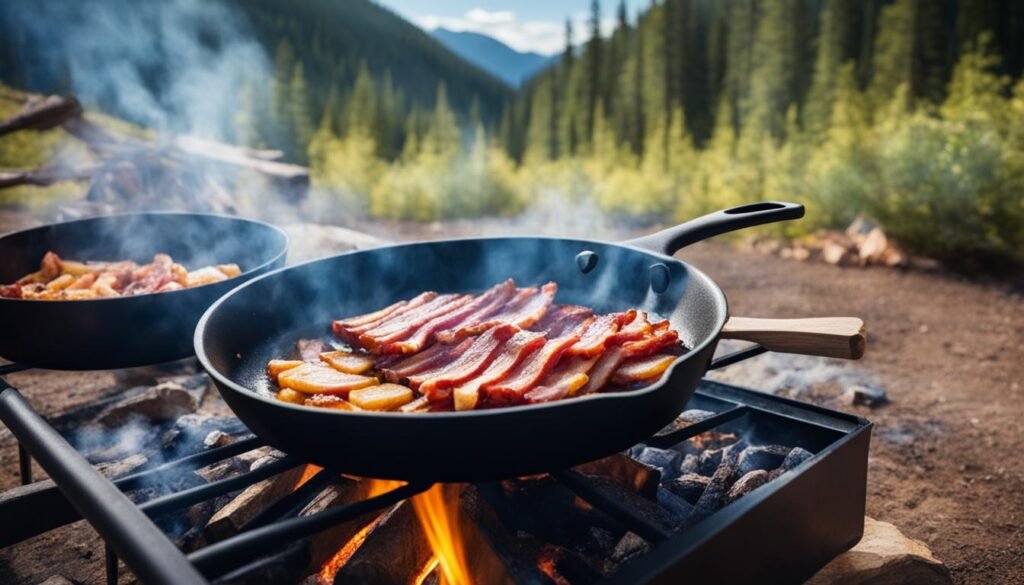There’s an art to the quintessential campfire feast, one that ties the primal tradition of open fire steak grilling to the refined techniques of today’s outdoor cooking. As an avid explorer of campfire cuisine, I have discovered that the majestic tomahawk steak, with its rich marbling and bone-in flavor, becomes an unforgettable gourmet adventure when kissed by the smoldering embers of a campfire.
The journey of learning how to cook a tomahawk steak on a campfire embraces more than just the process of grilling; it captures an experience that tantalizes the senses. It starts with the harmonious blend of flame and patience, requiring the fire to be built early so that it may settle into a bed of coals, infusing our coveted cut with the perfect whisper of smoke, which amplifies the beefiness without overshadowing it.
Key Takeaways
- Intensity of campfire coals is paramount for imparting a delicate smokiness to the tomahawk steak.
- Campfire steak grilling is not merely cooking; it’s an immersive outdoor culinary art form.
- Understanding the nuances of open fire cooking is crucial for mastering campfire cuisine.
- Choose the right moment to start grilling, only after the fire has mellowed to coals.
- Outdoor cooking techniques involve both innovation and proactive fire management.
- A profound experience awaits those who meld the natural elements with gastronomic skill.
Understanding the Majesty of the Tomahawk Steak
Within the realm of fine dining and wilderness steak preparation, the tomahawk steak holds a regal position. This sizeable and visually stunning cut, reminiscent of an ancient weapon, embodies the opulence and robust flavor that steak enthusiasts crave. But before one begins crafting a sublime tomahawk steak recipe, it’s imperative to grasp the anatomy of this cut and the nuances that play into its selection and taste.
Defining the Tomahawk Cut
The tomahawk steak is akin to a piece of edible art, bearing an impressively long bone which lends the steak its iconic silhouette. This cut generally spans a ribeye steak, known for its rich marbling and succulence, with the bone extending at least five inches beyond the meat, making it both a visual and gastronomic focal point. Its resemblance to the Native American throwing axe from which it draws its name is not just whimsical but practical, allowing the steak to be deftly maneuvered over flames.
The Alluring Impact of Bone-in Flavor
Connoisseurs often attest to the heightened flavor that bone-in cuts afford. As heat permeates through the bone during the cooking process, the marrow infuses the surrounding meat, offering an increased depth of flavor considered unattainable in boneless cuts. It’s a phenomenon that enhances the wilderness steak preparation, marrying the primal instincts of campfire cooking with the sophistication of contemporary culinary practices.
Selecting the Perfect Tomahawk for Your Campfire
Securing the ideal tomahawk steak begins with a personal pilgrimage to your trusted butcher, for few grocery stores will casually stock such an extravagant item. To ensure a superior grilling experience, inspect the steak for lush, even marbling and an unmistakable fresh appearance. Only USDA Prime or Choice grades, known for their exceptional quality, should make the cut. Ensuring the steak is approximately 2 to 2.5 inches in thickness ensures not just majestic presentation but also necessitates a perfect cooking time on the open flames.
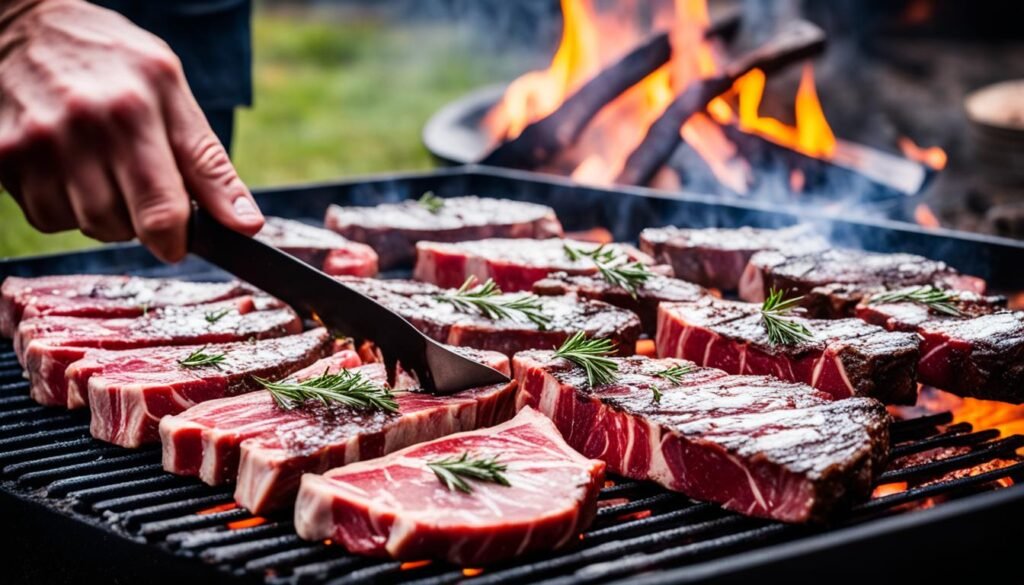
Knowing that selecting the perfect steak is part art and part science, here is a table to assist in choosing the best cut for your tomahawk steak recipe:
| Attribute | Description | Why It Matters |
|---|---|---|
| Marbling | Distribution of intramuscular fat | Contributes to juiciness and flavor |
| Thickness | Steaks should be 2 to 2.5 inches thick | Ideal thickness for even cooking and heat penetration |
| Grade | USDA Prime or Choice | Indicates higher quality and better taste profile |
| Freshness | Vibrant red color, no off-odors | Fresher steak ensures better taste and texture |
| Bone Length | At least 5 inches beyond the meat | Signature appearance and aids in handling |
Embarking on the journey of wilderness steak preparation requires a discerning eye for detail and a hearty appreciation for the grandeur of the tomahawk steak. Ensuring you start with the right cut is the first step towards a campfire feast worthy of legend.
Preparations for Grilling Your Tomahawk Steak Outdoors
Before we ignite the flames for an al fresco tomahawk steak sensation, the magic begins with preparation and seasoning, which are as essential as the grilling itself. These preliminary steps are crucial in enhancing the flavors that will soon dance across our palates. I pride myself in endorsing a method that weaves tradition with a pinch of personal flair, encouraging evolution within our campfire meal ideas.
Seasoning Techniques for Enhanced Flavor
For a transcendent taste experience, I liberally season my prized steak with timeless kosher salt – a true cornerstone in every griller’s arsenal. This not only heightens the innate flavors of the tomahawk but also facilitates the glorious crust we seek under the campfire’s glow. Anointing the steak with a generous slab of butter, or better yet, a melange of compound butter infused with garden-fresh herbs, introduces an orchestra of flavors that permeate deep into the fibers of the beef.
Watching the butter melt and mingle with the seasoning to form an aromatic cloak around the steak is, for me, a small ritual that foreshadows the feast to come. Here’s a tip for the uninitiated yet passionate campfire culinary aficionado: Let the steak bask in the gentle warmth of the outdoor air, which aligns the meat’s temperature with that of the great outdoors for a more even cook.
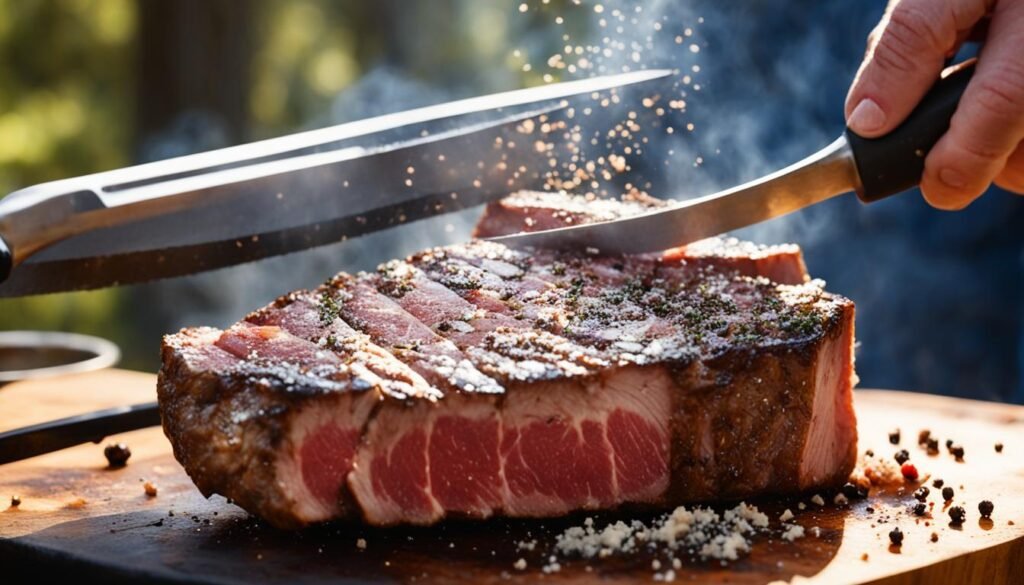
The Art of Aging and Marinating
Embracing the art of aging and marinating, I often find myself preparing well before the actual day of grilling. This patience pays off in dividends of depth and dimensions of taste. For those who delight in campfire cooking tips that transform good into great, consider either dry-aging your tomahawk steak if time allows or bathing it in a marinade that whispers secrets of smoke and earthiness.
My personal mantra resonates with simplicity, and often I let the steak speak for itself, but for those seeking something with a bit more narrative, a peppercorn rub or a soy and mustard-based marinade can elevate your story to that of legend in campfire meal annals.
With our preparations in tow, we’re on the cusp of culinary alchemy where muscle turns to tender morsels under the watchful eye of the flames. Let’s gather our grilling gear, tomahawk steak in hand, and step closer to the fire – our outdoor kitchen awaits.
Mastering Campfire Construction for the Perfect Sear
As a professional copywriting journalist focused on the outdoor cooking landscape, my latest foray into open fire steak grilling has brought forth a wealth of knowledge and experience in constructing the ideal campfire. Crafting the ultimate open flame experience for grilling a majestic tomahawk steak demands attention to detail in the assembly and maintenance of the campfire that will ensure a sumptuous feast.
Choosing Your Wood for Optimal Heat and Smoke
The choice of wood is a fundamental element when looking to optimize both heat and smoke, which are pinnacle factors contributing to the outdoor cooking techniques required for an impeccable tomahawk steak. Seasoned woods like hazel or birch are preferred by seasoned grill masters for their consistent burn and flavor-enhancing smoke that does not overpower the natural taste of the steak. To achieve the perfect sear, the wood selection should cater to the precise heat levels necessary for rendering the fat and crisping the exterior for that desirable steakhouse-quality crust.
Creating a Two-Zone Fire for Versatile Cooking
The expertise in open fire steak grilling truly shines when one has mastered the two-zone fire technique, creating an efficient, versatile heat source ideal for cooking a sizable tomahawk steak. The two-zone method involves a hotter space with lively embers for searing and a cooler area for slower, indirect heating, allowing for more precise control of cooking temperatures. Layering the foundation with smaller sticks and progressively adding larger pieces of wood results in sustained, robust coals that can be manipulated to provide the perfect balance of heat for each stage of cooking.
Constructing this type of fire requires finesse and an understanding of airflow and wood combustion. Over my career, I have honed a meticulous method that maintains a steady supply of ember beds without suffocating the flames, a technique I’m eager to share with budding outdoor chefs. By applying this knowledge, one can elevate their grilling game, ensuring every outdoor cooking escapade yields an exquisitely seared and flavor-packed tomahawk steak.
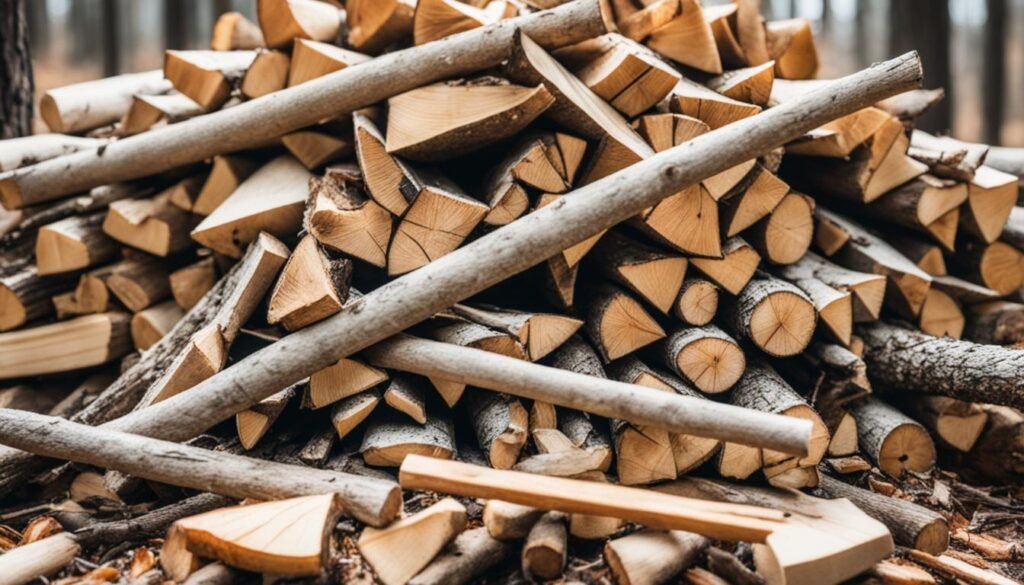
Now with our campfire roaring steadily, we are set to embark upon the grilling adventure that awaits. We’ll leverage the confluence of firecraft and culinary prowess to transform a raw cut of prime beef into a delectable interpretation of campfire cuisine. Stay tuned as we continue to delve into the particulars of how to cook a tomahawk steak on a campfire with finesse and style.
How to Cook a Tomahawk Steak on a Campfire
Embarking on the culinary quest of learning how to cook a tomahawk steak on a campfire is akin to performing a symphony with nature’s orchestra. At first glance, grilling this imperial cut of beef might seem daunting, but with campfire cuisine, the right techniques, and a bit of finesse, any aspiring outdoor chef can produce a masterpiece. Let me take you through the essential steps to ensure your tomahawk steak is not merely cooked, but celebrated in the great outdoors.

The first chord in our symphony begins with patience; the key ingredient in enhancing the art of open fire grilling. It starts by igniting your campfire well in advance to allow the wood to burn down into a bed of glowing embers, perfect for a two-zone grilling strategy. This technique provides a hot zone for searing and a cooler zone, preventing overcooking and championing precise control over temperature.
- Start by laying your tomahawk steak on the cooler side of the grill to gently bring it up to an internal temperature of around 120 degrees F. This is the quintessential first step in achieving a succulent, evenly cooked interior.
- Once this crucial temperature is essayed, transfer your steak to the fiery side, where the radiant heat encapsulates the steak, forming the coveted crust.
- The performance peaks as you sear the steak to an internal temperature of 130 degrees F, the sweet spot for a medium-rare doneness.
But the recital isn’t complete without the encore. As important as the grilling itself is the act of resting the steak post-sear. Tent your tomahawk with a piece of foil and let it rest so the juices redistribute within the meat. This pause consolidates the flavors and textures, ultimately enhancing the campfire cuisine experience.
To illustrate the methodical approach to grilling a tomahawk steak on a campfire, below is a table that captures the essence of timing and temperature control – the linchpins that will guide you towards exceptional campfire cuisine.
| Stage of Cooking | Temperature | Location on Grill | Outcome |
|---|---|---|---|
| Initial Cooking | Indirect heat until steak reaches 120°F | Cooler side of the grill | Evenly cooked interior |
| Searing | Direct heat until steak reaches 130°F | Hotter side of the grill | Gloriously crusted exterior |
| Resting | Off the grill, tented with foil | Aside from the heat | Juices redistribute for perfect succulence |
With the tomahawk now grilled to perfection, it’s ready for the grand finale: serving it up as the centerpiece of your campfire feast. Encourage all present to take a moment and appreciate the beauty of campfire cuisine at its finest. As I always say, the proof of the pudding—or in this case, the steak—is in the eating. Enjoy the fruits of your labor savored against the tranquil backdrop of nature, and let every bite reaffirm that the art of how to cook a tomahawk steak on a campfire is one of life’s simple yet profound pleasures.
Garnishes and Presentation: Adding the Final Touches
When the final embers of our campfire die down, and the grand tomahawk steak rests, it heralds the time for those finishing touches that transform the rustic into the gourmet. With the right garnishes and presentation techniques, the fruits of our labor amassed through the knowledge of how to cook a tomahawk steak on a campfire will be revealed in all its glory. It’s here, at the culmination of our cooking journey, that we truly appreciate the finesse of campfire cooking tips.
Pairing with the Right Garnishes
As the peak of the outdoor culinary experience stands before us, the careful selection of garnishes is paramount. A sprinkle of fresh shaved Parmesan cheese brings forth a nutty sophistication which, when coupled with freshly ground black pepper, creates a symphony of flavors, enhancing yet never overshadowing our main attraction. A final pinch of coarse salt, like a magician’s last flourish, completes the flavor profile, ensuring every bite resonates with the epic warmth and soulfulness of a campfire feast. This blend of simple yet bold accents honors the robust nature of the tomahawk steak while adding a touch of refinement.
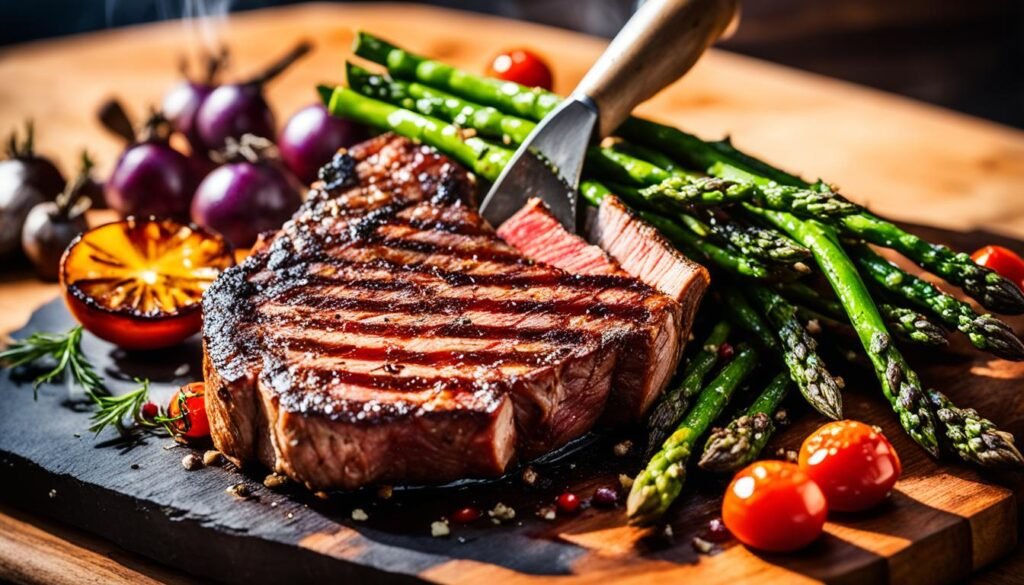
Carving and Serving Techniques for Show-Stopping Presentation
Beyond the sizzle and the sear comes the true testament to a master griller’s prowess: carving and serving. A steak, especially one as monumental as the tomahawk, must be presented with the precision and respect it deserves. With a confident but delicate touch, I carve the steak away from the bone, celebrating its heft and heritage. Then, against the grain, I slice with intention, unlocking the perfect tenderness at each cut—a performance executed against the crackling backdrop of the campfire, arresting in its simplicity and honesty.
The art of plating is as much a part of campfire cuisine as the grilling itself. As I fan the slices atop a ruggedly elegant serving board, it invites the gaze to linger, admire, and finally, to partake. It’s an open invitation to dive into a meal where the beauty of the outdoors converges with the splendor of a flawlessly grilled steak. The presentation, a veritable ovation to texture, taste, and technique, sets the stage for an outdoor feast that is nothing short of legendary.
Complementing Your Campfire Tomahawk Steak with Sides
When I speak of campfire cuisine, not only do I wax poetic about the succulent wilderness steak preparation, but my culinary narrative extends to the accompaniments that round out the meal. Pairing a robust al fresco tomahawk steak with the right sides uplifts the dining experience amid the whispers of the wilderness, transforming it from a mere meal to a holistic outdoor feast. Now, let me share with you sides that harmonize with the primal allure of the tomahawk steak, completing the gastronomic journey under the open sky.
Suggested Sides to Elevate Your Outdoor Feast
Let’s start by picturing a steak that’s been kissed by fire, its savory aroma mingling with the evening air. You now have the centerpiece of your campfire table, but what symphony is complete without the accompaniment of a well-orchestrated side? A twirl of smoked Brussels sprouts, for instance, adds a textural contrast with their charred leaves, while their nuttiness complements the richness of the steak.
Perhaps you’re in the mood for the creamy indulgence of smoked mac and cheese, where each spoonful drenched in smoky aura becomes a molten counterpoint to the tomahawk’s robust charm. Or maybe, a chilled smoked potato salad would serve to refresh the palate between bites of hearty steak, the smoky hints therein mirroring the essence of your meal’s campfire origins.
No matter the selection, each of these sides carries a whiff of smoke and a promise of delight, turning your wilderness dining into an elevated culinary escapade.
Al Fresco Dining: Bringing Elegance to the Great Outdoors
However, let us not forsake those who pledge allegiance to carnivorous exploits, for whom the tomahawk is not merely a part of the meal but rather its soul. For these stoic souls, a side of keto creamed spinach awash with creamy goodness accentuates the steak without overwhelming the senses. Another luxurious companion could be smoked crab imperial; it’s a mound of seasoned crustacean that graces the palates with an elegance rarely encountered in the rustic settings of al fresco dining.
The very essence of campfire fare revolves around the ability to commune with nature, and every side dish selected is a respectful nod to this serene setting. It intertwines simplicity with complexity, a duality much like the untamed wilderness itself. Therefore, our choice of sides not only serves to satiate hunger but also to honor the dance of flavors and textures reminiscent of an opulent outdoor banquet.
| Side Dish | Texture and Flavor Profile | Complement to Tomahawk Steak |
|---|---|---|
| Smoked Brussels Sprouts | Charred and nutty | Adds contrast and complements beefiness |
| Smoked Mac and Cheese | Creamy and smoky | Indulgent counterpoint to steak’s heft |
| Smoked Potato Salad | Chilled and subtly smoky | Refreshes palate, pairing smoke with smoke |
| Keto Creamed Spinach | Velvety and rich | Enhances without overtaking the main dish |
| Smoked Crab Imperial | Seasoned and luxurious | Adds an exquisite touch of seafood elegance |
In closing, the sides you choose to adorn your tomahawk steak with are not mere afterthoughts but vital supporting characters that promise to make your campfire tale one for the ages. As your al fresco tomahawk steak sizzles over the open flame, remember that these choices bolster the narrative of your outdoor feast, enveloping you and your guests in a dining experience that is both grounded and elevated by the hands of nature.
In every sliver of steak, in every spoonful of side, dwell the stories of campfires past and whispers of the wilderness—a testament to the transformative power of food, al fresco.
Campfire Cooking Tips for the Aspiring Grill Master
As I stand by the warmth of the crackling flames, poised to impart my seasoned wisdom on campfire cuisine, I can’t help but reflect on the essential outdoor cooking techniques that elevate a simple campfire gathering into a culinary event. To achieve that iconic steakhouse quality in the wild, a litany of tried-and-tested campfire cooking tips await their sharing.
The primal allure of cooking over an open fire is undeniable, but mastering this art requires more than just instinct—it demands methodical precision. From ensuring your tomahawk steak acclimates to ambient temperature before meeting the grill, to employing a strategic two-zone heating method, these are the pillars upon which memorable outdoor feasts are built.
Let’s delve into the critical steps I take to guarantee that every slab of beef that graces my campfire grill stands testament to my grill mastery:
- First, patience guides my hand as I allow the tomahawk steak to escape the confines of the cooler, resting until it’s one with the tranquil air of the great outdoors. This crucial step ensures that steak warms evenly and cooks consistently when introduced to the heat.
- Introducing butter atop the near-finished steak takes what might already seem like culinary perfection up a notch, imparting a velvety finish and a glossy, flavor-packed crust that defines steak excellence.
- Crucial to avoiding the plagues of uneven cooking and flare-ups is the mastery of the two-zone fire. Like a maestro swaying to the symphony of the grill, I maneuver the steak from the gentler zone to the inferno’s edge, creating an amalgam of textures that sing of smokiness and succulence.
- With the performance nearing its close, the timeless practice of allocating rest—steak draped tenderly under the foil—imbues every fiber with juiciness. This brief repose renders the tomahawk a mouthwatering marvel, worthy of the most selective palates.
The intervention of technology, in the form of a trusty meat thermometer, cannot be understated. It pierces to the steak’s heart, revealing with certainty when that crucial threshold between underdone and overcooked is neared and surpassed. The mastery of these nuances contributes to a finesse in campfire cooking that I take pride in nurturing.
Retrospectively, as a campfire crackles below the starlit sky, these nuggets of wisdom are not just measures but gateways to elevating one’s grilling craft. My dedication to these outdoor cooking techniques has yielded countless moments of culinary brilliance—an offering to fellow grill masters aspiring to turn their campfire experience into a gastronomic charge.
| Tip | Technique | Importance |
|---|---|---|
| Room Temperature Steak | Let steak acclimatize to outdoor temperature before grilling | Ensures even cooking and a succulent center |
| Two-Zone Fire Mastery | Create areas of direct and indirect heat | Provides control for perfectly searing and cooking through |
| Butter Topping | Add a pat of butter to the steak as it finishes cooking | Gives rich flavor and a steakhouse-quality finish |
| Resting Time | Allow steak to rest tented in foil after grilling | Juices redistribute, resulting in a tender and flavorful steak |
| Reliable Meat Thermometer Use | Use thermometer to check for desired doneness | Prevents over/under cooking for the perfect steak |
In essence, these hallmark campfire cooking tips come down to an interplay of anticipation and reaction—preparing for each phase of the grilling experience while also remaining adaptable to the dynamic nature of open fire. As an aspirant in the art of campfire cooking, embracing these tips with reverence will endow your outdoor feasts with the signature of true grill mastery.
Pitfalls in Campfire Steak Grilling and How to Avoid Them
As an advocate for impeccable campfire cuisine, I understand that perfecting the tomahawk steak recipe over an open fire is an art. Yet, even the most experienced outdoor chefs can encounter setbacks. Recognizing the common open fire steak grilling mistakes and knowing how to sidestep them is crucial for culinary success.
Mistakes That Can Ruin Your Campfire Steak Experience
One of the cardinal sins in campfire steak grilling is impatience. Many are eager to place their steak over the flames, but cooking over heavy smoke can overpower the delicate flavor profile of a high-quality tomahawk steak. Patience is key. Allow the fire to mature into a state where smoke gracefully enhances, rather than dominates, the beef’s taste.
Another misstep often witnessed is disregarding the framework of two-zone heat. Without this approach, you risk an unevenly cooked steak with potentially charred or undercooked sections. This critical technique separates the good from the outstanding in the realm of steaks grilled over an open fire.
Last of all is the miscalculation of skipping the resting phase after grilling. The steak’s juices need time to redistribute, and omitting this step can result in a tomahawk steak that’s less moist and flavorful than its potential promises.
Troubleshooting Common Outdoor Grilling Struggles
What distinguishes a grill master from a novice is their ability to troubleshoot these grilling blunders. Masterful fire management is instrumental. It involves building the fire correctly, fostering coals of the right temperature, and resisting the urge to fiddle with the wood or coals once the steak is on the grill.
As for preventing uneven cooking, I always suggest using a reliable meat thermometer. It’s an invaluable tool for ensuring your tomahawk reaches the ideal internal temperature for your preferred level of doneness before searing.
To avoid compromising the integrity of your steak after grilling, patience must be exercised. Resist the temptation to slice into the steak immediately after removing it from the heat. Instead, adhere to the traditional wisdom that respects the resting period, allowing the steak to succumb to its final metamorphosis before serving.
By respecting the process and implementing these corrective measures, your foray into the art of campfire cuisine will yield a tomahawk steak that reverberates with flavor, juiciness, and the satisfaction of having avoided the pitfalls of open fire steak grilling. Embrace these insights, and elevate your outdoor grilling prowess to new heights.
Can the Techniques for Cooking a Steak Over a Campfire be Applied to Cooking a Tomahawk Steak?
Yes, the techniques for cooking a steak over a campfire can definitely be applied to cooking a tomahawk steak. The key is to create a hot, even heat and to cook the steak for the appropriate amount of time to achieve the desired level of doneness.
Conclusion
Embarking on the adventure of creating an ultimate campfire feast has brought us through a meticulous journey, alighting upon every necessary step to perfect the tomahawk steak recipe. From the selection of the ideal cut—rich in marbling and fresh from the hands of a skilled butcher—to the orchestrated dance of seasoning, searing, and resting, each action coalesced into a symphony of flames and flavors.
This culmination of skill, patience, and passion has carved out more than just an impressive dish; it has enshrined a moment in time where food, fire, and nature intertwine to redefine campfire meal ideas. The very act of grilling over an open flame has become a testament to the art of cooking, transforming a special occasion into an unforgettable experience that ignites the senses and creates memories seared in both mind and palate.
For me, the true reward lies not only in the succulence of a perfectly grilled tomahawk steak but in the shared connections fostered around the glowing embers of a campfire. It’s more than a meal; it’s an extension of tradition, a marriage of rustic charm and culinary finesse. Whether set against the backdrop of starry skies or the amber hues of a sunset, this ultimate campfire feast encapsulates the embodiment of al fresco dining at its most luxurious.
FAQ
What Is the Best Technique for Cooking a Tomahawk Steak on a Campfire?
The best technique is to start by letting the steak reach room temperature. Use two-zone heating on your campfire to manage direct and indirect heat. Begin cooking on the cooler side and finish by searing over direct heat for a perfect crust. Remember to let the steak rest before carving to ensure juiciness and flavor.
What Makes a Tomahawk Steak Ideal for Campfire Grilling?
A tomahawk steak is ideal for campfire grilling due to its exceptional marbling and thick cut, which allow it to remain juicy and flavorful when exposed to the smoky environment of an open fire, adding an iconic taste that distinguishes campfire cuisine.
How Do I Choose the Right Wood for Cooking a Tomahawk Steak?
Choose seasoned hardwoods such as hazel or birch that offer a long-lasting burn and consistent heat. The type of wood can also influence the smoky flavor of the steak, so select wood that complements the natural flavors of the meat.
Can You Give Campfire Cooking Tips for an Al Fresco Tomahawk Steak Experience?
Absolutely! Ensure your tomahawk steak is at room temperature before grilling, utilize a two-zone fire for even cooking, season the steak generously, and finish every steak with butter for a rich taste. Always use a meat thermometer to check for the perfect doneness and give the steak enough rest time post-grilling.
What Sides Pair Well with a Campfire Grilled Tomahawk Steak?
Robust sides like smoked Brussels sprouts, smoked mac and cheese, smoked potato salad, keto creamed spinach, or smoked crab imperial complement the richness of a tomahawk steak, enhancing the outdoor dining experience while embracing the wilderness setting.
What Are Common Mistakes to Avoid When Grilling a Tomahawk Steak on a Campfire?
Common mistakes include starting to grill when the campfire is too smoky, not preparing a two-zone fire, and not letting the steak rest after cooking. To avoid these, allow your fire to reach the right temperature, create a heat gradient, and don’t rush the resting period for the meat.
How Do I Create a Two-Zone Fire for Cooking My Steak?
Begin by constructing your campfire with smaller sticks and gradually add larger wood pieces, ensuring a sustainable burn. Once you have a bed of embers, push most to one side to create a high heat zone, while leaving fewer embers on the other side for lower heat, creating your two-zone fire necessary for effective outdoor cooking techniques.
What Type of Seasoning Should I Use for My Tomahawk Steak?
Use kosher salt, cracked black pepper, and other preferred steak seasonings to enhance the beefy flavors. For added complexity, consider using compound butters, like herb-infused butter, to impart additional richness.
How Should I Serve My Grilled Tomahawk Steak for the Best Presentation?
Carve the steak off the bone and slice against the grain for maximum tenderness. Garnish with fresh Parmesan, black pepper, and a sprinkle of coarse salt. Present the slices fanned out next to the bone for a dramatic and appetizing display, highlighting your outdoor cooking skills and the splendor of open fire steak grilling.

